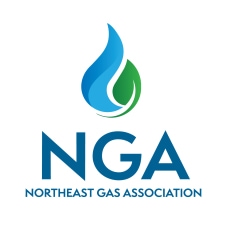Gas and Power Generation
Natural gas is one of the key fuel inputs for electric power generation. New technology, particularly combined-cycle technology, made the natural gas power plant the generating system of choice in recent years in the U.S. In the Northeast region, natural gas represents about 50% of installed generating capacity. This page summarizes some of the key trends in the regional natural gas/electric power interconnection.
Gas Plant Advantages: Lower Emissions, Higher Efficiency
The comparative advantages of natural gas power generation include higher efficiency, lower heat rate, shorter construction lead times, and reduced air pollutant emissions compared to other
fossil fuels.
The rise in natural gas use in power generation over the last two decades has been a key factor in achieving lower air emissions in the region, from sulfur dioxide to carbon dioxide. In June
2021, U.S. EIA noted that CO2 emissions from the U.S. electric power sector fell by 32% from 2005 to 2019. EIA observed: "Although both the increased use of renewables and the
shift from coal-fired to natural gas-fired generation contributed to reductions in electric power sector CO2 emissions, the shift from coal to natural gas had a larger
effect." EIA estimates that almost 65% of the decline in CO2 power sector emissions nationally over this time period is attributable to the shift from coal-fired to natural
gas-fired electricity generation.
At the regional level, the same dynamic is in play. In New York State over the last 20 years (from 2000-2021), NY ISO reports that emissions rates from the power sector dropped by 46% for
CO2, ~92% for NOx, and 99% for SO2.
PJM reports that between 2005 and 2021, CO2 emission rates fell 35% across its footprint, while nitrogen oxides dropped by 85% and sulfur dioxide by 94%.
ISO-NE reported in April 2022 that in the period between 2001 and 2020, generator emissions on its system declined by 99% for SO2, 78% for NOx, and 42% for
CO2.
Natural gas generation also increases average plant efficiency. As noted by EIA in July 2020: "In recent decades, the U.S. electric power grid's fuel mix has shifted from mostly coal to a
more diverse selection of fuels, including natural gas and renewable energy. In particular, the shift toward newer, more efficient natural gas-fired power plants with combined-cycle
generators has resulted in an increase in the average efficiency of fossil fuel-fired electric power plants and in lower levels of overall conversion losses."
Gas Seen as Integral Part of Power
Sector in Coming Decades
Natural gas is positioned to be among the leading fuels for electric power generation in the next decade (and beyond), along with renewables. Gas is also a key fuel input for new technology options like fuel cells, combined heat and power, and distributed generation.
Natural gas is also seen as the key "back-up fuel" to offset the variability and intermittency of some other resources. As the U.S. EIA noted in August 2020: "Natural gas is a key power generation resource because it has the flexibility to supply electricity at any time, including at times of peak demand. In contrast, some renewable energy technologies and nuclear power plants may be nondispatchable and not able to adjust their generation to meet load. For example, nuclear power plants may already be running at or near maximum capacity and may be unable to respond to shifts in load."Natural gas plays a major role in the energy mix in New York State. In May 2022, the FERC noted that in NYISO, natural gas capacity will account for 59% of all summer capacity in summer 2022.
In its 2021 state profiles released in March 2022, PJM reports that natural gas represents 66.5% of total installed capacity in New Jersey, and 16.5% of new interconnection requests in the state (as of 12-31-21). For Pennsylvania, natural gas represents 44.8% of total installed capacity statewide, and 13.8% of new interconnection requests. PJM notes in its "2021 Regional Transmission Expansion Plan," released in March 2022, that "Aging infrastructure, grid resilience, a shifting generation mix and more localized reliability needs are now more frequently driving new system enhancements...PJM's RTEP process continues to manage an unprecedented capacity shift driven by federal and state public policy and broader fuel economics. This shift is characterized by:
- New generating plants powered by Marcellus and Utica shale natural gas
- New wind and solar generating units driven by federal and state renewable incentives
- Generating plant deactivations
- Market impacts introduced by demand response and energy efficiency program."
Natural gas vehicles provide many benefits, from improved environmental performance to a domestic supply base to competitive economics. It is a proven and available technology ready today to help North America and the Northeast U.S. meet its alternative fuel transportation goals. Some highlights of the various benefits are included here:
Environmental
The Northeast U.S. is actively promoting alternatively-fueled vehicles to help address the region's air pollution challenges.
Natural gas vehicles are clean, and are available now!
Typical dedicated NGVs can reduce exhaust emissions of:
- Carbon monoxide (CO) by 70%
- Non-methane organic gas (NMOG) by 87%
- Nitrogen oxides (NOx) by 87 percent
- Carbon dioxide (CO2) by 20 to 30% below those of diesel and gasoline vehicles.
The U.S. Department of Energy's alternative fuel vehicle website notes: "Commercially available medium- and heavy-duty natural gas engines have demonstrated over 90% reductions of carbon
monoxide (CO) and particulate matter, and more than 50% reduction in nitrogen oxides (NOx) relative to commercial diesel engines."
The evidence is clear: natural gas vehicles are part of the environmental solution.
Supply
North America's natural gas supply base is vast. NGVs run on abundant domestic supplies.
The U.S. is the largest producer of natural gas in the world. Its extensive supply resource ensures security of supply and contributes to a generally stable commodity price.
In February 2022, the U.S. EIA reported that the Appalachian region "has provided the largest share of U.S. domestic natural gas output, accounting for one-third of Lower-48 production since
2016."
This positive supply news was reiterated in fall 2021 when the Potential Gas Committee released its 2020 biennial report: Potential Supply of Natural Gas in the United States. The updated
assessment finds that the United States possesses a total technically recoverable natural gas resource base of 3,368 trillion cubic feet (Tcf). The Atlantic area ranks as the country's
"richest resource area" with 39% of total U.S. gas resources. Most of this Atlantic regional growth results from the production and resource base associated with the Marcellus and Utica shale
plays in the Appalachian basin.
Economic
For natural gas, the new domestic supply additions, principally from shale gas, has created a positive price position.
It is projected by the U.S. government that the natural gas price bandwidth will stay relatively moderate over the coming years, given the size of the domestic supply resource base.
The U.S. Department of Energy Alternative Fuels Data Center maintains a database on comparative costs of transportation fuels. You can find the data comparison here:
http://www.afdc.energy.gov/afdc/price_report.html
For these reasons and more, natural gas vehicles offer great opportunities to the Northeast and the U.S. market.
For these reasons and more, natural gas vehicles offer great opportunities to the Northeast - and the U.S. - market.
The mission of NGA's NGV Committee is as follows:
to promote and support the advancement of natural gas vehicles (NGVs) in the Northeast region and to serve as a regional voice and information source on NGVs/CNG/LNG.
For further information on CNG vehicles, visit the following web sites:
Recent NGA Presentations
- Renewable Natural Gas Coalition, Fall 2016
- Barry Carr, Landi Renzo USA, Corporate Overview, 4-28-16
- Dave Myers, Hexagon Composites, CNG Mobile Pipeline, 4-28-16
- Mark Babcock, Algas-SDI, CNG Systems, 4-28-16
- DERIVE Systems, 9-24-15
- Meredith Webber, Gas Storage & Transportation, Luxfer-GTM Technologies, 9-24-15



